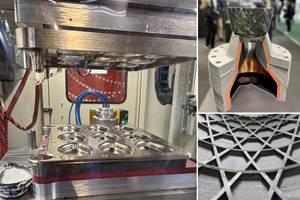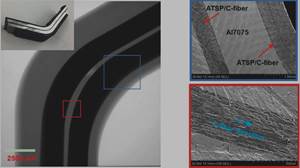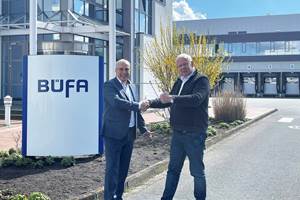AFRL pushes limits of polymer additive manufacturing
Air Force Research Laboratory research team has successfully printed the highest-temperature capable, reinforced polymer composite parts.
Researchers at the Air Force Research Laboratory’s Materials and Manufacturing Directorate (Wright-Patterson Air Force Base, OH, US) are “turning up the heat” in the field of polymer additive manufacturing.
In conjunction with researchers at NASA’s Glenn Research Center (Cleveland, OH, US) and the University of Louisville (Louisville, KY, US), the team successfully printed the highest-temperature capable, reinforced polymer composite parts using additive manufacturing. Consisting of a high temperature thermoset resin infused with carbon fiber filaments, this state-of-the art material breakthrough sets the stage for next generation, cost-efficient Air Force manufacturing needs.
“This is an extremely impactful breakthrough in composite material additive manufacturing,” says Dr. Hilmar Koerner, a scientist on the Polymer Matrix Composite Materials and Processing Research Team and the driving force behind the novel discovery. “These 3D printed parts can withstand temperatures greater than 300° Celsius, making them potentially useful for turbine engine replacement parts or in hot areas around engine exhaust.”
Polymer matrix composites are extremely attractive to Air Force researchers working on next-generation applications due to their light-weight properties and ability to withstand extreme conditions in high temperature environments. This plays an important role in increasing aircraft range while reducing fuel consumption, both of which are key to reducing operating costs over the long term.
Typically, polymer composites consist of a fiber, such as glass, embedded in a matrix or resin made of epoxy or other material. The embedded fibers reinforce the matrix, making the resulting material stronger.
During a polymer additive manufacturing technique called laser sintering, a high temperature laser is run across a bed of polymer powder to form a pre-designed, computer generated shape. This process is repeated multiple times with new layers of powder and laser energy until a 3D part is complete.
While experimenting with high temperature polymer resins, Koerner and his team found that the polymers printed well, but when they removed the pieces from the powder bed for post-processing, the material would essentially “melt into puddles,” proving useless.
To counteract this issue and better enable molecules to entangle and form a shape under the heat of the laser, Koerner suggested adding carbon fiber filler to the resin material as a means of enabling better energy transfer from the laser to the matrix. The carbon fiber would cause the laser to heat the material much faster by absorbing the laser energy and conducting heat much faster than with the polymer alone.
As a result, the researchers successfully printed high temperature polymer composite sample pieces in multiple configurations, in what, to their knowledge, are the highest temperature capable, polymer composite parts made by additive manufacturing to this day.
“High temperature materials are notoriously hard and expensive to process, even using conventional manufacturing techniques,” says Dr. Jeffery Baur, a principal materials engineer at AFRL. “Since they typically wind up being used in military specific applications, there is not a large supplier base for these types of materials. This breakthrough will enable us to additively manufacture high temperature, composite parts in a cost-efficient manner. Moreover, high temperature polymer composite parts that are small and have complex features will be extremely beneficial and advantageous not only for the Air Force, but have the potential to be a game-changer throughout industry.”
The team successfully printed a number of test coupons and brackets with the novel material and plan to demonstrate the ability to print larger parts as the next step in their process. Preliminary test data indicates that the material can withstand elevated temperatures, but further testing and qualification of the material is needed prior to implementation on Air Force platforms.
Nevertheless, this is a significant breakthrough in additive manufacturing with huge, cost saving benefits for the Air Force over the long term.
“This is a high, value-added capability for the Air Force,” says Baur. “We are excited about this breakthrough and look forward to seeing the impacts over the future.”
Related Content
JEC World 2024 highlights: Thermoplastic composites, CMC and novel processes
CW senior technical editor Ginger Gardiner discusses some of the developments and demonstrators shown at the industry’s largest composites exhibition and conference.
Read MoreFlexible, induction-based heating for thermoplastic composite part repair
Spinning off from a German Aerospace Center (DLR) research project, msquare GmbH’s technology aims to innovate and enable repair for high-temperature thermoplastics.
Read MoreNew polymer expands composites options in demanding environments
Aromatic thermosetting copolyester offers unique properties, availability in multiple form factors.
Read MoreAOC, Büfa expand distribution partnership
Through newly formed Büfa Composites Austria, customers in southeast Europe will have access to resins, gelcoats and auxillary materials.
Read MoreRead Next
Composites end markets: Energy (2024)
Composites are used widely in oil/gas, wind and other renewable energy applications. Despite market challenges, growth potential and innovation for composites continue.
Read MoreCW’s 2024 Top Shops survey offers new approach to benchmarking
Respondents that complete the survey by April 30, 2024, have the chance to be recognized as an honoree.
Read MoreFrom the CW Archives: The tale of the thermoplastic cryotank
In 2006, guest columnist Bob Hartunian related the story of his efforts two decades prior, while at McDonnell Douglas, to develop a thermoplastic composite crytank for hydrogen storage. He learned a lot of lessons.
Read More
.png;width=70;height=70;mode=crop)
























